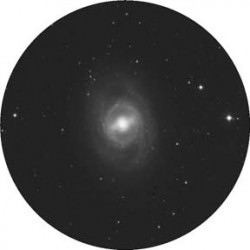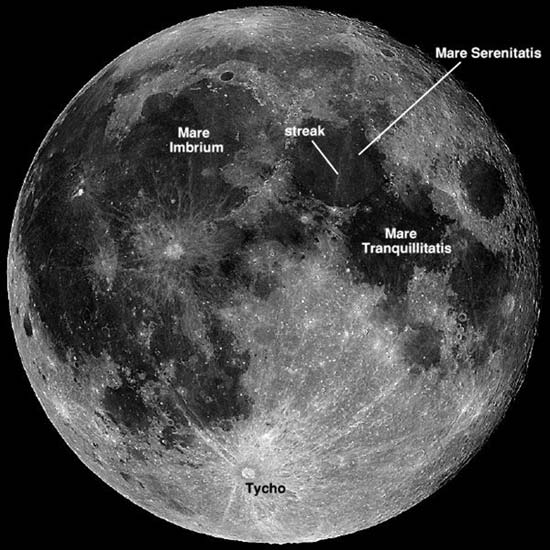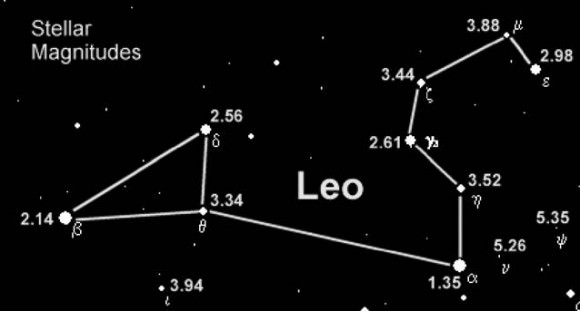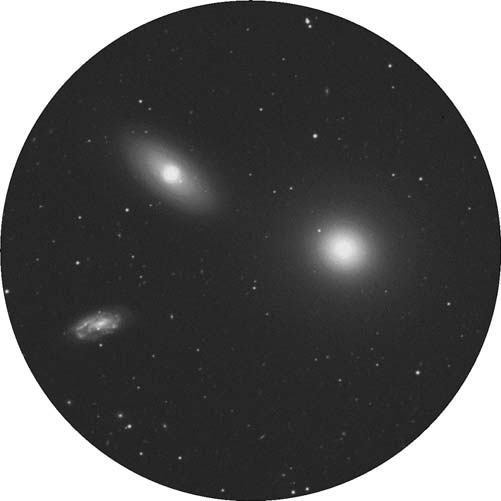Greetings, fellow SkyWatchers! It’s a green “Corn Moon” weekend and time to get out of the house and enjoy the night sky! Enjoy sharing “Moon Illusion” with friends or simply spotting bright features with easy optics. In the mood to kick back and stargaze? The learn more about the constellation of Leo and what to look for when skies are bright. If you’re ready for a challenge, then try your hand at a few bright galaxies by holiday’s end. Whenever you’re ready, I’ll see you in the backyard….
 May 28, 2010 – Today, we begin by saluting the 1930 birth on this date of Frank Drake, father of Project Ozma and formulator of the ‘‘Drake Equation,’’ used to estimate the number of technological civilizations that may exist in our galaxy. Dr. Drake also worked with Carl Sagan on the plaques placed aboard Pioneers 10 and 11, which greet any visitors the probes might encounter. Also remember Rudolph Leo B.Minkowski on this 114th anniversary of his birth. Minkowski studied spectra and contributed to the discovery of more than half of the planetary nebulae now known. Along with Walter S. Baade, Minkowski separated supernovae into spectral types and identified optical counterparts for early radio source galaxies.
May 28, 2010 – Today, we begin by saluting the 1930 birth on this date of Frank Drake, father of Project Ozma and formulator of the ‘‘Drake Equation,’’ used to estimate the number of technological civilizations that may exist in our galaxy. Dr. Drake also worked with Carl Sagan on the plaques placed aboard Pioneers 10 and 11, which greet any visitors the probes might encounter. Also remember Rudolph Leo B.Minkowski on this 114th anniversary of his birth. Minkowski studied spectra and contributed to the discovery of more than half of the planetary nebulae now known. Along with Walter S. Baade, Minkowski separated supernovae into spectral types and identified optical counterparts for early radio source galaxies.
Tonight is the ‘‘Full Flower Moon.’’ Earth is awakening again! Agricultural literature refers to it as the ‘‘Full Corn Planting Moon,’’ or the ‘‘Milk Moon.’’ No matter what it’s named, Moonrise is majestic to watch. Participate in a Lunar Club Challenge and do some outreach work by demonstrating ‘‘Moon Illusion’’ to someone. We know it’s purely psychological and not physical, but the fact remains that the Moon seems larger on the horizon. Using a small coin held at arm’s length, compare it to Luna as it rise, and then again as it seems to ‘‘shrink’’ as it moves up! You’ve now qualified for extra credit.
Try using colored or Moon filters to look at the many surface features that throw amazing patterns across its surface. If you have none, a pair of sunglasses will suffice. Look for things you might not ordinarily notice, such as the huge streak emanating from crater Menelaus, the pattern projected from Proclus, or the bright tiny dot of little-known Pytheas north of Copernicus. It’s hard to miss the blinding beacon of Aristarchus! Check the southeastern limb, where the edge of Furnerius lights up the landscape.. or how a nothing crater like Censorinus shines on the southeast shore of Tranquillitatis, while Dionysus echoes it on the southwest. Could you believe Manlius just north of central could be such a perfect ring, or that Anaxagoras would look like a northern polar cap? Although it might be tempting to curse the Moon for hiding the stars when it’s full, there is no other world outvthere that we can view in such detail – even if you just look with your eyes!
May 29, 2010 – Today we begin with the 1794 birth on this date of Johann Heinrich von Madler who, along with Wilhelm Beer, published the most complete map up to that time of the Moon, Mappa Selenographia. How fitting it is then, that we should have the bright Moon tonight! Before the Moon rises, take a look at the constellation of Leo and its brightest stars.
Our first destination is 85 light-year-distant Regulus. As the 21st brightest star in the night sky, 1.35-magnitude Alpha Leonis is a helium star about 5 times larger and 160 times brighter than our own Sun. Speeding away from us at 3.7 kilometers per second, Regulus is also a multiple system whose 8th magnitude B companion is easily seen in small telescopes. Regulus B is also a double, with a magnitude 12 dwarf companion of uncertain type. There’s an additional 13th magnitude star in this grouping, but it’s probably not associated with Regulus, since the ‘‘Little King’’ is moving toward it and will be very close to it in 800 years.
About a fist-width northeast of Regulus is 2.61-magnitude Gamma Leonis. Algieba is a very fine double star, but difficult to see at low power, since the 90 light-year distant pair is bright and close. Separated by about twice the diameter of our own Solar System, the gap between Algieba and its companion is slowly widening! Another two finger-widths north is 3.44-magnitude Zeta. Aldhafera is about 130 light-years away and also has an optical companion—35 Leonis. Remember this binocular pair, because they’ll lead you to galaxies later! Before we leave, look east for 3.34-magnitude Theta. Mark this one in your memory, because Chort and 3.94-magnitude Iota to the south serve as markers for a galaxy hop! Last is easternmost 2.14 magnitude Beta. Denebola is the ‘‘Lion’s Tail’’ and has several faint optical companions.
 May 30, 2010 – Today we begin with the 1423 birth of Georg von Peuerbachon this date, a follower of Ptolemy’s astronomy. Georg calculated eclipses; observed Halley’s Comet before it was so named; and created astronomical instruments. Following Georg nearly half a millennium later was Hannes Alfven, born in 1908. Alfven’s life work was plasma and its electric and magnetic forces. Lastly, we have Aleksei Arkhipovich Leonov, who was born in 1934. Leonov was the first man to climb out of a spacecraft (the Voskhod II ) and into space. He was the first true ‘‘astrophotographer’’ as he filmed for 10 minutes while orbiting!
May 30, 2010 – Today we begin with the 1423 birth of Georg von Peuerbachon this date, a follower of Ptolemy’s astronomy. Georg calculated eclipses; observed Halley’s Comet before it was so named; and created astronomical instruments. Following Georg nearly half a millennium later was Hannes Alfven, born in 1908. Alfven’s life work was plasma and its electric and magnetic forces. Lastly, we have Aleksei Arkhipovich Leonov, who was born in 1934. Leonov was the first man to climb out of a spacecraft (the Voskhod II ) and into space. He was the first true ‘‘astrophotographer’’ as he filmed for 10 minutes while orbiting!
Tonight’s study is for mid- to large-aperture telescopes. Begin by heading west about a fist-width from Regulus and identify 52 Leonis. Our mark is 1.5 degrees south. At lower power, you’ll see a triangle of galaxies.
The largest and brightest is M105 (RA 10 47 49 Dec +12 34 54). This dense elliptical galaxy appears evenly distributed, but the Hubble Space Telescope (HST) revealed a huge mass within the core equal to about million suns. The companion elliptical to the northeast— NGC 3384—reveals a bright nucleus and an elongated form. The faintest of this group— NGC 3389—is a receding spiral; larger scopes will see ‘‘patchiness’’ in structure.
 Continue another degree south and enjoy another galactic pair. The widely spaced M96 (RA 10 46 45 Dec +11 49 10) and M95 (RA 10 43 57 Dec +11 42 12) belong to a galaxy grouping called Leo I. The dusty spiral—M96—will appear as a silver oval, with a nucleus much sharper than its faint spiral arms. M96 hosted a supernova as recently as 1998. To its west, you’ll discover a beautiful barred spiral—M95—a prime target of the HST. Visually, we enjoy M95 for its unique ring-like arms and unmistakable barred core, but the HST was looking for Cepheid variables to help determine the Hubble constant. Although we don’t need a space telescope to view this group of galaxies, we can appreciate taking a 38-million-light-years journey from our own backyard!
Continue another degree south and enjoy another galactic pair. The widely spaced M96 (RA 10 46 45 Dec +11 49 10) and M95 (RA 10 43 57 Dec +11 42 12) belong to a galaxy grouping called Leo I. The dusty spiral—M96—will appear as a silver oval, with a nucleus much sharper than its faint spiral arms. M96 hosted a supernova as recently as 1998. To its west, you’ll discover a beautiful barred spiral—M95—a prime target of the HST. Visually, we enjoy M95 for its unique ring-like arms and unmistakable barred core, but the HST was looking for Cepheid variables to help determine the Hubble constant. Although we don’t need a space telescope to view this group of galaxies, we can appreciate taking a 38-million-light-years journey from our own backyard!
Until next week? Dreams really do come true when you keep on reaching for the stars!
This week’s awesome photos are (jn order of appearance): Frank Drake (archival image), Full Moon courtesy of NASA, Leo courtesy of NASA, Aleksei Arkhipovich Leonov (archival image), M105 and M95 – Palomar Observatory, courtesy of Caltech. We thank you so much!





Great read again for the weekend Tammy,I much agree on shooting the moon with Luminace,Red,Blue,Green filters,(LRGB)
I only do my moon shotsthat way now,Only way you get all the detail an color,below’s 5-27-10 1am 99.9% full moon shot i done in LRGB with Nexstar8SE an CanonT1i with 6.3 reducer
http://media.kickstatic.com/kickapps/images/6696/photos/PHOTO_9407489_6696_7585054_main.jpg
YIPPEE! It looks like tonight I’ll finally have a clear sky and a (near) full moon to test the lunar image projector I made!
I will experiment with the Lee Filters (243 colors) and GamColor (100 colors) photographic filter samples I have. Thanks for the suggestion!